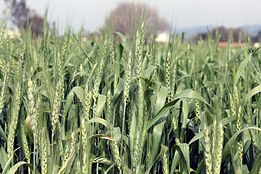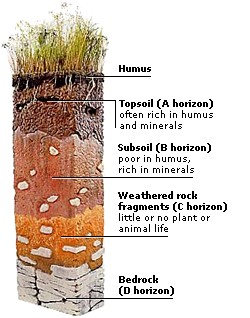Food is one of the basic necessities of living. Food provides necessary energy to function our body like body functions, such as digestion, respiration and excretion. We get our food from plants, or animals, or both.
In order to provide food for a large population— regular production, proper management and distribution is necessary.

Agricultural Practices 
Paddy a kharif crop
Earlier human beings used to wander here and there in groups and ate raw fruits, vegetables and started hunting animals to eat. Later, they could cultivate land and produce rice, wheat and other food crops. Thus, was born ‘Agriculture’.
When plants of the same kind are cultivated at one place on a large scale, it is called a crop. For example, crop of wheat means that all the plants grown in a field are that of wheat. crops are of different types like cereals, vegetables and fruits. These can be classified on the basis of the season in which they grow.


There are two types of crops in India, farmers grows these are according to season:
(i) Kharif Crops : The crops which are sown in the rainy season are called kharif crops. The rainy season in India is generally from June to September. Paddy, 


Maje Soyabean Ground nut

Cotton

(ii) Rabi Crops : The crops grown in the winter season (October to March) are called rabi crops. Examples of rabi crops are wheat, gram, pea, mustard and linseed.


Wheat Gram 

Pea Mustard

linseed(flax seed)

There are certain pulses and vegetables are grown during summer at many places.

Basic Practices of Crop Production
There are certain steps for growing crops, which have to followed :
(i) Preparation of soil
(ii) Sowing
(iii) Adding manure and fertilisers
(iv) Irrigation
(v) Protecting from weeds
(vi) Harvesting
(vii) Storage

Preparation of Soil:
Preparation of soil is the first step in the agricultural process. In this farmer preparing the soil means making it loosen up , this allows roots to breathe easily and to absorb all nutrients from soil.


The loosened soil helps in the growth of earthworms and microbes present in the soil. These organisms are friends of the farmer since they further turn and loosen the soil and add humus to it. Loosening of soil brings the nutrient-rich soil to the top so that plants can use these nutrients.


The process of loosening and turning of the soil is called tilling or ploughing. This is done by using a plough. Ploughs are made of wood or iron. Soil must be moist before ploughing so that manure and soil mix well.

Agricultural Implements
There are 3 main tools which are used for ploughing, sowing and harvesting the crop.
This is done with the help of various tools. The main tools used for this purpose are the plough, hoe and cultivator:

Plough : This has been used since ancient times for tilling the soil, adding fertilisers to the crop, removing the weeds and turning the soil. This is made of wood and is drawn by a pair of bulls or other animals (horses and camels).


The indigenous wooden plough is increasingly being replaced by iron ploughs nowadays.
देशी लकड़ी के हल की जगह आजकल लोहे के हलों ने ले ली है।
Hoe : It is a simple tool which is used for removing weeds and for loosening the soil. It has a long rod of wood or iron. A strong, broad and bent plate of iron is fixed to one of its ends and works like a blade. It is pulled by animals.



Mechanical Hoe Manual Hoe

Cultivator : Nowadays ploughing is done by tractor-driven cultivator. The use of cultivators saves labour and time.

Sowing
Sowing means putting seeds inside the soil. Now farmers choose seeds very carefully for good production. Farmers mostly prefer high yielding seeds.
Traditional tool : The tool used traditionally for sowing seeds is shaped like a funnel . The seeds are filled into the funnel, passed down through two or three pipes having sharp ends. These ends pierce into the soil and place seeds there.

Seed drill : Nowadays the seed drill is used for sowing with the help of tractors. This sows the seeds uniformly at equal distance and depth. It ensures that seeds get covered by the soil after sowing. This protects seeds from being eaten by birds. Sowing by using a seed drill saves time and labour.


Adding Manure and Fertilisers
After sowing seeds in the field, a farmer needs to feed manure and fertilizers to soil for providing important nutrients to soil which leads to excellent production of good quality food grains.

Why a farmer need manure and fertilizers to field, some farmers don't let or afford that their field empty or unsowen after one crop harvested, so they cultivate crops after crops this leads to decrease the fertility of soil, so in this situation a farmer needs to add manure and fertilizers to his crops and soil.

Now there are differences between manure and fertilizers.
खाद और उर्वरक के बीच अंतर।
Fertiliser | Manure |
Fertiliser is a man-made inorganic salt. उर्वरक एक मानव निर्मित अकार्बनिक नमक है।
| Manure is a natural substance obtained by the decomposition of cattle dung and plant residues. खाद एक प्राकृतिक पदार्थ है जो मवेशियों के गोबर और पौधों के अवशेषों के अपघटन से प्राप्त होता है।
|
Fertiliser is prepared in factories. उर्वरक कारखानों में तैयार किया जाता है।
| Manure can be prepared in the fields. खेतों में खाद तैयार की जा सकती है।
|
Fertiliser does not provide any humus to the soil. उर्वरक मिट्टी को कोई ह्यूमस प्रदान नहीं करते हैं।
| Manure provides a lot of humus to the soil. खाद मिट्टी को भरपूर मात्रा में ह्यूमस प्रदान करती है।
|
Fertilisers are very rich in nitrogen, nutrients. phosphorus and potassium उर्वरक नाइट्रोजन, पोषक तत्वों से भरपूर होते हैं। फास्फोरस और पोटेशियम
| Manure is relatively less rich in plant nutrients. खाद पौधों के पोषक तत्वों में अपेक्षाकृत कम समृद्ध है
|
Excessive use of fertilisers has made the soil less fertile. उर्वरकों के अत्यधिक उपयोग ने मिट्टी को कम उपजाऊ बना दिया है
| While manure increases fertility of soil. जबकि खाद से मिट्टी की उर्वरा शक्ति बढ़ती है।
|
Fertilisers have also become a source of water pollution. उर्वरक भी जल प्रदूषण का एक स्रोत बन गए हैं।
| Manure is natural therefore it doesn’t cause any pollution. खाद प्राकृतिक है इसलिए इससे कोई प्रदूषण नहीं होता है।
|
Fertilisers are chemicals which are rich in a particular nutrient. Example: urea, ammonium sulphate, super phosphate, potash, NPK (Nitrogen, Phosphorus, Potassium). उर्वरक ऐसे रसायन होते हैं जो एक विशेष पोषक तत्व से भरपूर होते हैं। उदाहरण: यूरिया, अमोनियम सल्फेट, सुपर फॉस्फेट, पोटाश, एनपीके (नाइट्रोजन, फास्फोरस, पोटेशियम)।

| Manure is an organic substance obtained from the decomposition of plant or animal wastes. खाद एक कार्बनिक पदार्थ है जो पौधे या पशु अपशिष्ट के अपघटन से प्राप्त होता है
. |
There are certain more advantage of natural and organic manure:
It enhances the water holding capacity of the soil.
It makes the soil porous due to which exchange of gases becomes easy.
It increases the number of friendly microbes.
It improves the texture of the soil.

Irrigation
Every living being needs water to live and for growth. Plants contain nearly 90% water. Water is essential because germination of seeds does not take place under dry conditions.
Water also protects the crop from both frost and hot air currents.The supply of water to crops at regular intervals is called irrigation. The time and frequency of irrigation varies from crop to crop, soil to soil and season to season.

Sources of irrigation : The sources of water for irrigation are— wells, tubewells, ponds, lakes, rivers, dams and canals.

There are two types of irrigation methods
Traditional irrigation method: traditional irrigation methods are age old techniques to water your field, it also means watering the field by animals or by humans itself. The water available in wells, lakes and canals is lifted up by different methods.
These methods are cheaper, but less efficient. The various traditional ways are: (i) moat (pulley-system) (ii) chain pump (iii) dhekli, and (iv) rahat (Lever system).
2.Modern Methods of Irrigation: these use machines for irrigation plus these are economical.




Moat chain pump


Dhekli rahat (Lever system).

(i) Sprinkler System: This system is more useful on uneven land where sufficient water is not available. The perpendicular pipes, having rotating nozzles on top, are joined to the main pipeline at regular intervals.


Drip system : In this system, the water falls drop by drop directly near the roots. So it is called a drip system. It is the best technique for watering fruit plants, gardens and trees.

Protection from Weeds
In a field many other undesirable plants may grow naturally along with the crop. These undesirable plants are called weeds.The removal of weeds is called weeding.


The manual removal includes physical removal of weeds by uprooting or cutting them close to the ground, from time to time. This is done with the help of a khurpi. It can also be controlled by weedicides, these are chemicals.

As weedicides are chemical, farmers have to take extra care so that it can’t affect the health of farmers.They should cover their nose and mouth with a piece of cloth during spraying of these chemicals.

Harvesting
Harvesting a crop is an important task. The cutting of a crop after it is mature is called harvesting.Harvesting in our country is either done manually by sickle or by a machine called harvester.



Sickle harvester
In the harvested crop, the grain seeds need to be separated from the chaff. This process is called threshing.Farmers with small holdings of land do the separation of grain and chaff by winnowing.

Storage
It is a very important step. If the harvested grains are to be kept for a longer time, they should be safe from moisture, insects, rats and microorganisms.
Harvested grain has more moisture, so they have to be sorted carefully and have to be sun dried to reduce the moisture in them. This prevents the attack by insect pests, bacteria and fungi.

Farmers store grains in jute bags or metallic bins. However, large scale storage of grains is done in silos and granaries to protect them from pests like rats and insects.

In the End we humans obtained different food items from plants and animals.Many people living in the coastal areas consume fish as a major part of their diet.
Animals reared at home or in farms, have to be provided with proper food, shelter and care. When this is done on a large scale, it is called animal husbandry.

Summary End
सारांश अंत
